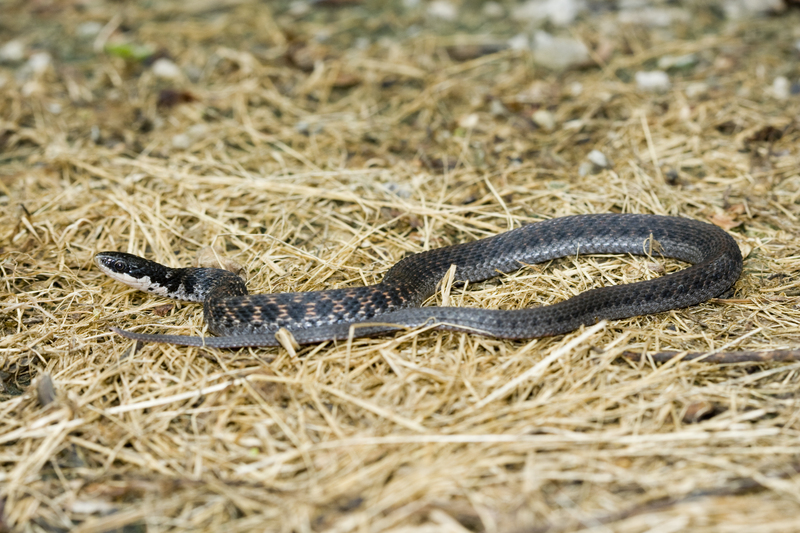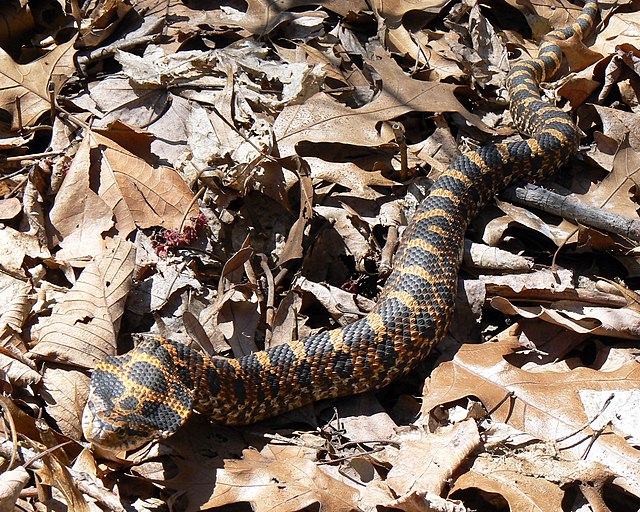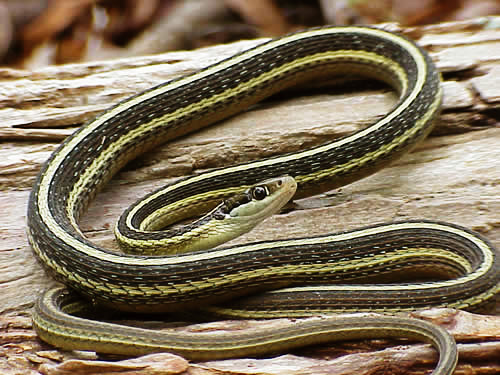There are 21 species of snake you may encounter in Pennsylvania. Snakes often cause fear, even though the majority of them are completely harmless to humans. Continue reading to find out more about the snakes you may come across when in Pennsylvania.
Table of Contents
Are There Venomous Snakes In Pennsylvania
Out of the 21 snake species in Pennsylvania, only three are considered venomous. These include:
- Northern Copperhead
- Timber Rattlesnake
- Eastern Massasauga
Types Of Snakes In Pennsylvania
The 21 species of snakes in Pennsylvania include:
1. Northern Copperhead

Scientific name: Agkistrodon contortrix mokasen.
Common name: northern copperhead.
Length: 61–91 cm (24–36 in).
Venomous: Yes.
Northern Copperheads can grow to a maximum of 53 inches (135cm).
They can be identified by the hourglass pattern that runs down their body. The dark chestnut cross bands that make the hourglass are narrower in the center and wider on the sides, there are often a series of dark spots between the cross banding.
You may see some dark spots on the side of the belly.
Their head is a distinct copper-red.
Juveniles are lighter than adults in color with the tip of their tails being yellow. They also have a dark line that runs through the eye. They darken with age and the yellow of the tail fades.
The Northern copperhead is a quiet and lethargic snake that will lie still or slowly move away if encountered. They will strike viscously if they are threatened or provoked.
They are common in the southern most parts of the state where they are common in suburban backyards, though they do prefer wooded hillsides with plenty of rocks, close to a permanent water source, such as a swamp or stream.
If bitten by a Northern Copperhead, ensure you seek immediate medical treatment.
Further Reading:
2. Timber Rattlesnake

Timber rattlesnake
Scientific name: Crotalus horridus.
Common name: timber rattlesnake, canebrake rattlesnake, banded rattlesnake.
Length: 30 – 60 in (76 – 152 cm)
Venomous: Yes.
Timber rattlesnakes grow to 60 inches (152cm) in length and can weigh up to 4.5kg (9.9lb).
They have keeled dorsal scales in black or dark brown crossbands over a yellow/brown or gray body. The crossbands have zig-zagged edges, some have a V or M shape. They usually have a rust-colored stripe. Their belly is yellow, sometimes with black markings.
The timber rattlesnake is not present in Laurel Highlands or in the southeastern areas. It is therefore not common in the two largest cities, Philadelphia and Pittsburgh.
If bitten by a Timber Rattlesnake, seek immediate medical treatment.
3. Eastern Massasauga

Scientific name: Sistrurus catenatus catenatus.
Common name: Eastern massasauga.
Length: 60 – 75 cm (24 – 30 in).
Venomous: Yes.
Eastern Massasaugas can grow to 30 inches (75cm) and have tan or gray bodies with a row of black to brown colored blotches or spots, which run down the center of their backs with three small rows of alternating spots down their sides.
There have been solid black specimens encountered, along with those where the black patches join on the sides. Juveniles are lighter in color.
Their venom destroys the tissue and medical treatment should be secured if you are bitten by one of these snakes.
This snake can be encountered in Allegheny, Beaver, Butler, Crawford, Lawrence, Mercer, and Venango counties.
This species has rapidly declined, mostly due to habitat loss
4. Eastern Worm snake

Scientific name: Carphophis amoenus.
Common name: Eastern worm snake.
Length: up to 11 in (28 cm)
Venomous: No.
Eastern worm snakes are small snakes growing to 11 inches (28cm) in length. They have smooth and glossy scales. They can be dark brown to tan and without patterns.
There is a pink ventral pigmentation, which spreads onto the dorsal first and second scale rows.
They have small heads that are the same thickness as the neck.
These small and harmless snakes can be found in the pine woods, hardwood forests, wooded areas, and old fields in southeastern Pennsylvania, where they are usually encountered not far from wetland borders and streams.
Further Reading:
5. Kirtland’s Snake

Scientific name: Clonophis kirtlandii.
Common name: Kirtland’s snake.
Length: 18 in (46 cm).
Venomous: No.
Kirtland snakes are slim and small, growing to 18 inches (46cm) in length.
They are gray to brown with black dots on their backs with alternating smaller dots down the sides. They have brick red ventral scales with a black spot on the outer end.
They prefer forests, wetlands, and grasslands. They are never far from a water source.
If encountered, they will flatten their body and become rigid. They can curl up into the smallest disc to hide from threats. There is no record of bites from this snake. They prefer hiding and fleeing from potential threats.
Found in western Pennsylvania, they are listed as an endangered species.
6. Northern Black Racer

Scientific name: Coluber constrictor constrictor.
Common name: northern black racer.
Venomous: No.
Northern black racers are exceptionally fast-moving snakes that prefer shrubland and grassy habitats.
These snakes are blue-black to black in color with a pale belly. They can grow up to five feet in length.
They are harmless to humans.
They are very active during the day.
This species is considered species of greatest conservation need.
They are often encountered in meadows, old fields, farmland, open woodlands, rock formations, and under logs, boards, and debris. You can encounter Northern black racers throughout Pennsylvania.
7. Northern Ring-necked Snake

Scientific name: Diadophis punctatus edwardsii.
Common name: Northern ringneck snake.
Length: 24 in (61 cm).
Venomous: No.
Northern ring-necked snakes can grow up to 61cm in length are black to blue-gray in color with a narrow orange or yellow ring around their necks. Their belly matches the ring without any patterns.
These are nocturnal snakes, hiding during the day under logs, leaf litter, and rocks. They are seldom observed. They prefer moist wooded areas, but they are known to live on the edge of wetlands and mountains, and hilly areas.
When encountered, it is normally in a humid and moist basement.
The northern ringneck snake is common in Western Pennsylvania.
8. Eastern Hog-nosed Snake

Scientific name: Heterodon platirhinos.
Common name: eastern hognose snake, spreading adder, deaf adder.
Length: around 28 in (71 cm)
Venomous: No.
Eastern hog-nosed snakes can grow up to 28 inches (71cm) with females being larger than the male.
What helps identify this snake is it has an upturned nose, which helps it dig in the soil and sandy.
They vary in color from orange and red to grays, blacks, browns, and greens. Some are a combination of colors. They can have patches, checks, or be completely patternless. Their belly is gray, cream, or yellow. The underside of the tail is usually lighter in color than the belly.
This snake is considered harmless to humans, but some people experience an allergic reaction to the bite, which can result in localized swelling. No human deaths have been recorded from a bite from the Eastern hog-nosed snake.
When they feel threatened, they mimic a cobra by flattening their necks and raising their heads. They hiss and strike, though they seldom try to bite. It may also roll over and play dead, giving off an awful smell to deter predators.
9. Eastern Milksnake

Scientific name: Lampropeltis triangulum triangulum.
Common name: Eastern milk snake.
Length: 52 in (132 cm).
Venomous: No.
Eastern milksnakes can grow to 52 inches (132cm) in length with smooth and shiny scales. They are brown with black edges, some have red to red/brown coloration. Their pattern has three to five black-bordered patches, which run down the length of their bodies. The body is tan or gray. Their belly is a black and white checkered pattern.
These harmless and docile snakes are popular as pets and are often bred in captivity for the pet trade.
They rarely try to bite and can be found throughout Pennsylvania.
10. Northern Watersnake

Scientific name: Nerodia sipedon sipedon.
Common name: banded water snake, black water adder, black water snake, brown water snake, common water snake, common northern water snake, eastern water snake, North American water snake, northern banded water snake, northern water snake, spotted water snake, streaked snake, water pilot.
Length: 24 – 55 in (61 – 140 cm)
Venomous: No.
Northern watersnakes can grow to 55 inches (1140 cm) and can range from red to gray, brown, or a brown/black color. They have dark crossbands on their necks with dark patches over the rest of the body. They darken with age, making their pattern hard to see, some have been described as completely black.
Their belly can range in color from gray to white or yellow with black or red crescents.
They are completely harmless to humans and are nonvenomous. They are often killed because they are confused with the venomous cottonmouth. The watersnake is longer with a flatter head, the head is the same width as the neck.
They are very active during the day and can be seen basking in the sun on rocks and logs on the water’s edge. They will fleet, diving into the water, at the slightest disturbance.
This is the most common watersnake in Pennsylvania.
11. Northern Rough Greensnake

Scientific name: Opheodrys aestivus.
Common name: (Northern) rough greensnake, grass snake, green grass snake.
Length: 116 cm.
Venomous: No.
Northern rough greensnakes are bright green snakes with a yellow belly. This helps them hide in the green vegetation, making them hard to see.
They grow to 116cm in length and are slim snakes.
They prefer woodlands and moist meadows and are usually found near a permanent water source. They are excellent swimmers, though they do climb low vegetation.
They are most common in the southern most portions of Pennsylvania where they can be encountered in moist habitats, lakes and river borders, meadows, and woodlands.
12. Smooth Greensnake

Scientific name: Opheodrys vernalis.
Common name: smooth green snake, grass snake.
Length: 14 – 20 in (36 – 51cm)
Venomous: No.
Smooth greensnakes are slender snakes that can grow to 20 inches (51cm). They are a light green color with a white or yellow belly. Their scales are smooth. Younger snakes are olive green or even brown until their first shed. They have a red tongue with a black tip which they use to smell their surroundings.
They can be encountered throughout Pennsylvania, often found in marshes, meadows, stream edges, open woods, and areas with an abundance of shrubs.
13. Eastern Ratsnake

Scientific name: Pantherophis alleghaniensis.
Common name: eastern ratsnake.
Length: 36 – 72 in (90 – 180 cm)
Venomous: No.
Eastern rat snakes grow to 72 inches (180cm) in length and are shiny black with a white or cream-colored throat and chin. These snakes have a black and white checkered pattern on their belly which changes to a gray closer to the tail. Younger snakes have dark patches on a gray color.
These snakes are considered harmless and are commonly found in Eastern Pennsylvania, where they live in farmlands, forests, fields, and thickets, as well as urban areas, such as back yards.
They are excellent climbers, which helps them get into homes undetected, where they move into attics.
14. Queensnake

Scientific name: Regina septemvittata.
Common name: queen snake.
Length: up to 24 in (61 cm).
Venomous: No.
Queen snakes can vary from dark brown or gray to olive in color with yellow to peach stripes down the length of the first row of scales. There are four dark ventral stripes. Their belly is yellow to cream in color. These snakes have narrow heads with plate-like scales on their heads.
They are not big snakes and can grow up to 24 inches (61cm).
They have specific habitat requirements and will not be found near clean running waters. Their diet is freshwater crayfish.
The queen snake can be encountered in the western third of Pennsylvania, between the northern and southern borders.
15. Northern Brownsnake

Scientific name: Storeria dekayi dekayi.
Common name: Northern brownsnake.
Length: 49cm.
Venomous: No.
Northern brownsnakes can grow to 49cm in length and are brown to gray in color. These harmless snakes have a light central stripe with black spots. They are light brown or even pink with black dots on the scales on the ventral side.
These snakes can be encountered throughout Pennsylvania, usually in grasslands, vacant lots, and forests.
16. Northern Red-bellied Snake

Scientific name: Storeria occipitomaculata.
Common name: Northern red-bellied snake.
Length: 4 – 12 in (10 – 31 cm)
Venomous: No.
Northern red-bellied snakes can be tan/brown, olive/brown, gray/brown, black, gray, or chestnut brown with three yellow spots just below the head shield. They are red brick or coral in color on their belly. Some have three black dots on their heads.
They grow to around 12 inches (31cm) where they live in gardens, forests, wetlands, and flowerbeds. They hide under logs and rocks and are common in Northwestern Pennsylvania.
17. Short-headed Gartersnake

Scientific name: Thamnophis brachystoma.
Common name: short-headed gartersnake.
Venomous: No.
The short-headed gartersnake is a small snake that grows to 22 inches (55cm). These snakes are olive green or olive with three yellow to beige stripes down their body.
These snakes can be encountered in Northern Pennsylvania where they are common in meadows and old fields. They are sometimes seen in wooded areas.
18. Ribbon Snake

Scientific name: Thamnophis saurita.
Common name: ribbon snake.
Length: 16 – 35 in (41 – 89 cm).
Venomous: No.
The ribbon snake is a species of garter snake and is not venomous.
They grow to 35 inches (89cm) in length are dark brown with yellow stripes.
The ribbon snake is common throughout Pennsylvania. They prefer wet climates such as lakes, marshes, streams, creeks, and wet woodlands.
They swim to catch their prey and will usually swim away if encountered.
19. Eastern Gartersnake

Scientific name: Thamnophis sirtalis sirtalis.
Common name: Eastern garter snake.
Length: up to 49 in (124 cm)
Venomous: No.
Eastern gartersnakes grow to 26 inches (66cm) in length. They can range from black to brown or gray with a white or yellow stripe.
They live in a host of different habitats, though they prefer shrubby and grassy areas. They are often encountered in trash dumps, outbuildings, and farmland. They are also known to live near lakes, streams, bogs, and ponds, along with urban areas such as cemeteries and gardens.
They can be encountered throughout Pennsylvania.
20. Mountain Earthsnake

Scientific name: Virginia pulchra.
Common name: mountain earthsnake.
Length: 13 in.
Venomous: No.
Mountain earthsnakes are small snakes that grow to 13 inches.
These non-venomous snakes are gray or brown with a pattern of black flecks. Their chins and belly are cream with the females being larger than the males.
They are seldom encountered as they prefer living underground.
They can vary in color from red-brown to brown or gray and they may have two rows of black dots that run the length of the body.
These snakes are common in Northwestern Pennsylvania.
21. Eastern Smooth Earthsnake

Scientific name: Virginia valeriae valeriae .
Common name: eastern smooth earth snake.
Length: 7 – 10 in (18 – 25 cm)
Venomous: No.
Eastern smooth earthsnakes are brown to gray in color with dark spots on their head plate. They have a small black ring around their eyes and the ventral surface of their head is white. Some have a faint light line, some have back spots on their back and sides.
These snakes can grow to 9.8 inches (25cm) in length.
They prefer spending their time buried under leaf litter or soil.
What To Do When You See A Snake
Whether you see a snake in the yard or in nature, the best course of action is to leave it alone. Most snakes will try and flee rather than be aggressive. Rather stand still or back away slowly to give the snake time to move on.
If you encounter a snake within the home, remove the people and pets from the room and close the door, covering the gap with a towel. It is recommended to a professional snake catcher to help remove the snake safety.
How To Prevent Snakes
The good news is that there are a few things you can do in your home and yard to prevent snakes, especially if you live in an area where visiting snakes is common.
Prevent Snakes in the Yard
There are a few things you can do to prevent snakes in your yard. These include:
- Remove rock and debris piles
- Keep the grass short
- Avoid overwintering which will attract birds, rodents, and things that snakes like to eat
- Don’t overdo the mulch
- Move your firewood away from the home
Prevent Snakes in the Home
You can also prevent snakes from entering the home, by trying the following:
- Seal foundation and concrete porch cracks
- Eliminate rodents
- Install a mesh fence that is buried at least two to four inches under the soil surface
- Remove any birdhouses
- Attach aluminum flashing to the bottom of your existing fence
- Use screens on windows and doors
- Use galvanized screening on vents and drains
How to Deter Snakes Already in the Home
If you have a snake or snakes that have already been taken to your home, then you can try:
- Sprinkle cinnamon, clove, or eugenol essential oils around the home, focusing on entryways
- Try using vinegar solutions, which repels snakes
- Plant garlic, lemon grass, and marigold plants around the home.
Summary
Not all snakes are bad, some do a lot for your yard and surrounding areas, by eliminating rodents and pests.
It is important to learn how to identify the three venomous snakes in Pennsylvania, so if you are bitten you can advise the medical team right away.
Preventing snakes in the home and yard is the best way to reduce the risk of having to encounter snakes on a regular basis.
Further Reading: